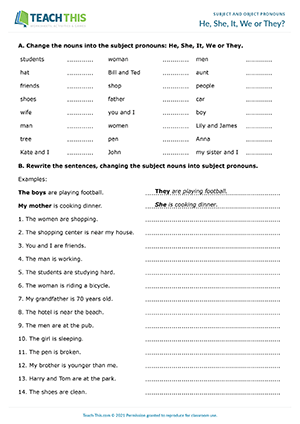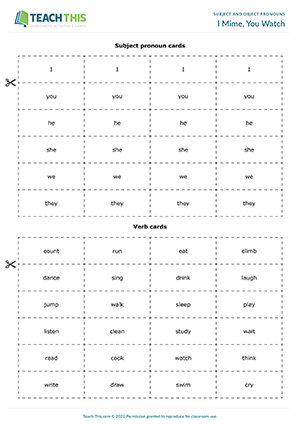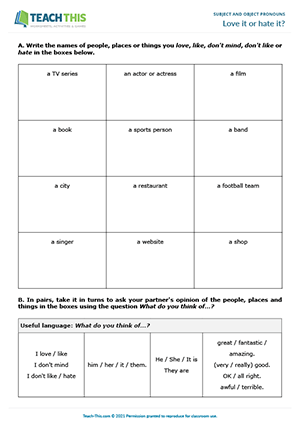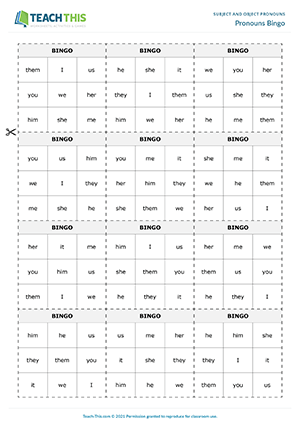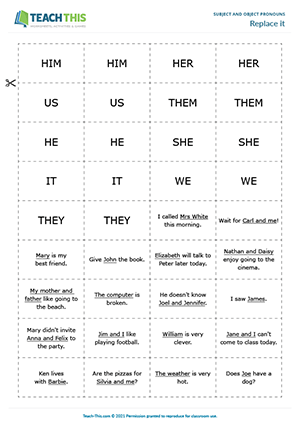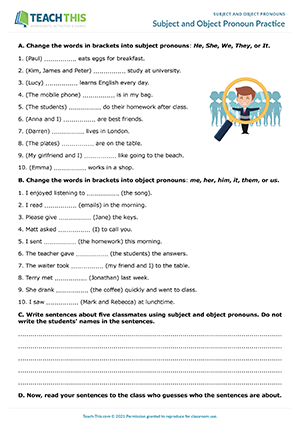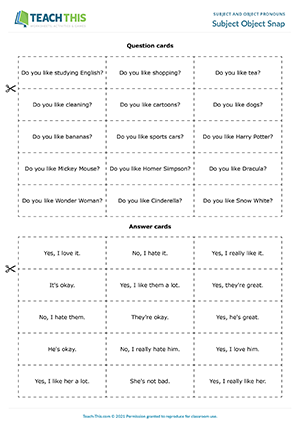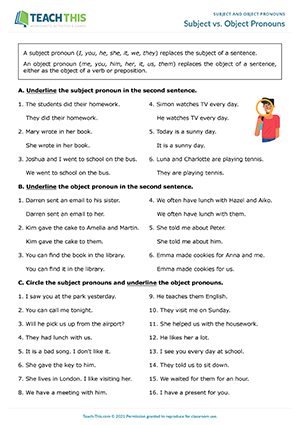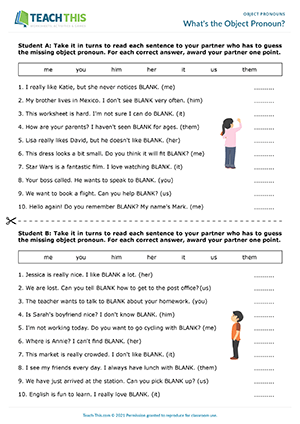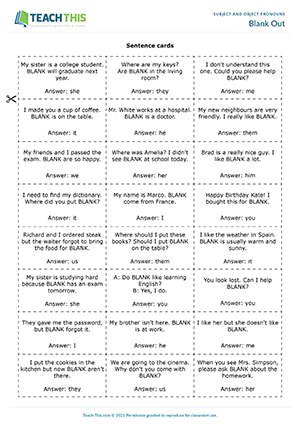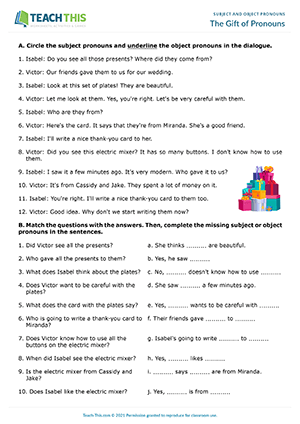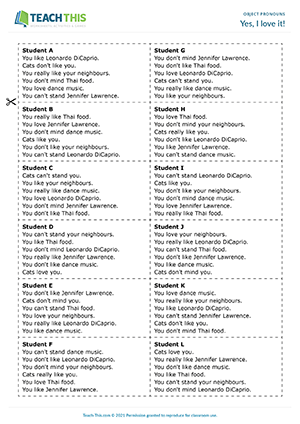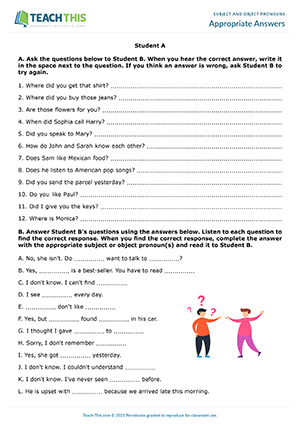Here is a free subject pronouns worksheet to help students practice the subject pronouns: He, She, It, We, They. To start, students change nouns on the worksheet into the subject pronouns: He, She, It, We or They. Students then rewrite sentences, changing the subject nouns into subject pronouns. Finally, review the answers with the class by having each student read out a sentence.
In this amusing subject pronouns game, students watch their classmates do mimes and race to guess the subject pronoun and verb by making a basic present simple or present continuous sentence. In groups, students take it in turns to pick up a subject pronoun card and a verb card and mime them to the other group members. To mime the subject pronouns, students indicate with their hand the type of pronoun, e.g. circling their hand for 'we', etc. The others students watch the mime and race to guess the subject pronoun and verb by making a sentence in the present simple or present continuous, depending on which tense you want the students to practice, e.g. 'We jump' or 'We are jumping'. The first student to say the correct sentence wins and keeps the two cards. The student with the most cards at the end of the game wins.
In this interesting subject and object pronouns speaking activity, students give opinions about people, places and things. Students think of people, places and things they love, like, don't mind, dislike or hate and write an answer under each heading on the worksheet. In pairs, students then take it in turns to ask their partner's opinion of the people, places and things under the headings using the question What do you think of...? For example, 'What do you think of Will Smith?' Their partner replies by giving their opinion using subject and object pronouns, e.g. 'I like him. He's really good'. When everyone has finished, students give feedback to the class on their preferences.
In this rewarding subject and object pronouns game, students play bingo by listening to gap-fill sentences and matching pronouns with the missing words. The caller reads a gap-fill sentence at random from the caller's sheet, saying the word 'blank' where the subject or object pronoun should go. The players listen to the sentence and check their bingo cards to see if a suitable subject or object pronoun from their card can be used in the sentence. If so, they cross the pronoun off their bingo card. The first player to cross off all nine pronouns on their card shouts 'bingo' and reads out the pronouns they crossed off. If the pronouns match with the sentences, the student wins the round and scores a point. Students play several rounds with a different student taking on the role of the bingo caller each time. The student with the most points at the end of the game is the winner.
In this fun subject and object pronouns game, students match and replace underlined words in sentences with subject or object pronouns. In pairs, students take it in turns to turn over one sentence card and one pronoun card. If the pronoun matches with the underlined word or words in the sentence, the student reads the sentence aloud, replacing the word or words with the subject or object pronoun on the card. The student then keeps the two cards and has another turn. If the cards don't match, the student turns them back over. The student with the most pairs of cards at the end of the game wins.
In this productive subject and object pronouns worksheet, students complete and write sentences with subject and object pronouns. First, students complete sentences by changing words in brackets into subject pronouns. Students then complete another set of sentences by changing words in brackets into object pronouns. Next, students write sentences about five classmates using subject and object pronouns, without writing the students' names in the sentences. Finally, students take turns reading their sentences to the class, who listens and tries to guess which students the sentences are about.
In this entertaining subject and object pronouns game, students play snap by matching Do you like...? questions with answers that contain subject and object pronouns. In pairs, both students turn over a card from their pile at the same time. If the question and answer match, the first student to say 'Snap' scores a point. Students then pick up their own cards, shuffle the pack and play again. Students do not pick up their partner's cards. If the question and answer don't match, students continue turning over cards until a matching pair comes up and someone says 'Snap'. If a student says 'Snap' when the answer doesn't match the question, the other student scores a point and the game continues. The first student to get ten points wins the game.
This comprehensive subject vs. object pronouns worksheet can be used to help introduce or teach subject and object pronouns. Students begin by identifying subject and object pronouns in sentences. Students then rewrite sentences, changing underlined words to subject or object pronouns. Finally, students complete a short story with subject and object pronouns.
In this free object pronouns game, students complete sentences with object pronouns. In pairs, students take it in turns to read each sentence to their partner using the word 'blank' for the missing object pronoun. Their partner listens and then repeats the sentence back, adding in a suitable object pronoun from the box on their worksheet. For each correct answer, students score one point. The student with the most points at the end of the game wins.
In this fast-paced subject and object pronouns game, students race to complete sentences with subject or object pronouns. In groups, the reader turns over a card and reads the sentence aloud to the players using the word 'blank' for the missing pronoun. The players listen and then race to grab the correct pronoun card to complete the sentence. The first player to grab the correct pronoun card from their set and give it to the reader, saying the pronoun at the same time wins and keeps the two cards. The student with the most cards at the end of the game wins.
In this useful subject and object pronouns worksheet, students identify and practice using subject and object pronouns. Students start by circling subject pronouns and underlining object pronouns in a dialogue. Next, students match questions with answers and then complete missing subject or object pronouns in the sentences. In the last exercise, students read a text and answer questions in sentence form using one subject pronoun and one object pronoun in each answer.
In this engaging object pronouns speaking activity, students ask questions about preferences and reply using object pronouns. The aim of the activity is to find someone who has all the same preferences. Students look at their preferences card and then stand up and ask a classmate a question with like in order to find the person who has the same preferences as them, e.g. 'Do you like Thai food?' Their classmate looks at the preferences on their card and answers using an appropriate object pronoun, e.g. 'No, I don't like it'. If a classmate responds with the same preference as the student asking the question (e.g. 'Yes, I love it'), the two students take it in turns to ask questions to see if all their preferences are the same. If so, the two students sit down together. When all the students have found a partner, they give feedback on what preferences they have in common with their partner according to their cards.
In this intriguing subject and object pronouns speaking activity, students answer questions by finding the correct response on a worksheet and completing it with an appropriate subject or object pronoun. Student A begins by asking their first question to Student B who listens and tries to find the correct response on their worksheet. When Student B finds the correct response, they complete the answer with the appropriate subject or object pronoun and read it back to their partner. If Student A agrees the answer is correct, they write the response in the space next to the question. If Student A thinks an answer is wrong, they ask Student B to try again. When all the questions have been answered, students swap roles. Finally, check the correct answers with the class by having students read out their responses.
Latest Free
Resources
- Everyday Objects Bingo
Everyday Objects
Elementary (A1-A2)
- Action Verb Races
Actions
Elementary (A1-A2)
- Birthday Basics
Birthdays
Elementary (A1-A2)
- Sales Phrasal Verbs
Business Phrasal Verbs
Upper-intermediate (B2)
Latest Member
Resources
- Collocations at Work
Business Collocations
Intermediate (B1)
- Etiquette Trivia Board Game
Etiquette and Manners
Upper-intermediate (B2)
- Everyday Objects Vocabulary
Everyday Objects
Pre-intermediate (A2)
- Let's have a talk
Verb-Noun Collocations
Pre-intermediate (A2)



